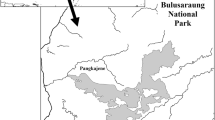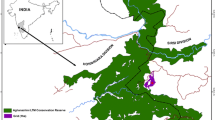Abstract
The chosen habitat of any animal species comprises a range of environmental features that provide adequate resources for its continuous survival. Consequently, the criteria of habitat selection by animals, combines a wider spectrum of both environmental and extrinsic factors, with major prerequisites based on food resources, availability of shelter and suitable ethics for procreation. From this study, conducted in winter and early spring, at Mt. Wangwushan area, located on 35°05′–35°15′ N, 112°12′–112°22′ E, in Taihangshan Macaque National Nature Reserve (TMNNR), Jiyuan, Henan Province, we show by elaborative results that Macaca mulatta tcheliensis was specifically associated with the following habitat characteristics: (1) the average tree DBH (diameter at breast height) with over 15 cm; (2) the distance from human disturbance of less than 2000 m; (3) the distance to water with less than 1000 m; (4) the gradient of mountain slope of 15°∼40°; (5) which was markedly tarrying with the altitude ranges from 1000 m to 1300 m; and (6) where the canopy coverage was less than 60%. In addition, during this study, rhesus macaque mostly inhabited the sunny slopes of mountains than the shady areas. Results of the first five principal components analysis (PCA) accounted for the total variance of 68.88%, while the other factors showed insignificant effects on habitat selection by rhesus macaque in the temperate forest. In conclusion, these new results increase our understanding on the living status, under the harshest condition, in winter and early spring of Macaca mulatta tcheliensis, the subspecies of rhesus macaques as may be linked to its habitat selection and utilization, in the temperate forest.
Similar content being viewed by others
References
Bond B.T., Burger L.W.Jr., Leopold B.D., Jones J.C. & Godwin K.D. 2002. Habitat use by cottontail rabbits across multiple spatial scales in Mississippi. J. Wildl. Manage. 66(4): 1171–1178. DOI: 10.2307/3802950
Bos D.G. & Carthew S.M. 2003. The influence of behaviour and season on habitat selection by a small mammal. Ecography 26(6): 810–820. DOI: 10.1111/j.0906-7590.2003.03584.x
Brown J.H., Mehlman D.W. & Stevens G.C. 1995. Spatial variation in abundance. Ecology 76(7): 2028–2043. DOI: 10.2307/1941678
Chesson J. 1978. Measuring preference in selective predation. Ecology 59(2): 211–215. DOI: 10.2307/1936364
Ferguson S.H. 2002. The effects of productivity and seasonality on life history: comparing age at maturity among moose (Alces alces) populations. Global Ecol. Biogeogr. 11(4): 303–312. DOI: 10.1046/j.1466-822X.2002.00289.x
Fooden J. 2000. Systematic review of the rhesus macaque, Macaca mulatta (Zimmermann, 1780). Fieldiana Zool. 96: 1–180. ISSN: 0015-0754
Goldstein S.J. & Richard A.F. 1989. Ecology of rhesus macaques (Macaca mulatta) in northwest Pakistan. Int. J. Primatol. 10(6): 531–567. DOI: 10.1007/BF02739364
Greenwood J.J.D., Gregory R.D., Harris S., Morris P.A. & Yalden D.W. 1996. Relations between abundance, body-size and species number in British birds and mammals. Philosoph. Trans. Roy. Soc. London B 351(1337): 265–278. DOI: 10.1098/rstb.1996.0023
Guo S.T., Ji W.H., Li B.G. & Li M. 2008. Response of a group of Sichuan snub-nosed monkeys to commercial logging in the Qinling Mountains, China. Conserv. Biol. 22(4): 1055–1064. DOI: 10.1111/j.1523-1739.2008.00975.x
Guo S.T., Li B.G. & Watanabe K. 2007. Diet and activity budget of Rhinopithecus roxellana in the Qinling Mountains, China. Primates 48(4): 268–276. DOI: 10.1007/s10329-007-0048-z
Guo X.B., Wang Z.L., Tian J.D., Lu J.Q. & Liu J.D. 2010. Sleeping site selection by rhesus macaques (Macaca mulatta tcheliensis) in Taihangshan National Nature Reserve, Henan, China. Sichuan J. Zool. 29(6): 849–856. DOI: CNKI: SUN:SCDW.0.2010-06-002
Hanya G. 2004. Diet of a Japanese macaque troop in the coniferous forest of Yakushima. Int. J. Primatol. 25(1): 55–71. DOI: 10.1023/B:IJOP.0000014645.78610.32
Harris S.W., Cresswell J., Forde P.G., Trewhela W.J., Woollard T. & Wray S. 1990. Home-range analysis using radio-tracking data: A review of problems and techniques particularly as applied to mammals. Mammal Rev. 20(2–3): 97–123. DOI: 10.1111/j.1365-2907.1990.tb00106.x
Homan H.J., Linz G.M. & Bleier W.J. 2000. Winter habitat use and survival of female ring-necked pheasant (Phasianus colchicus) in southeastern north Dakota. Amer. Midl. Nat. 143(2): 463–480. DOI: 10.1674/0003-0031(2000)143[0463:WHUASO]2.0.CO;2
Hu Y.M., Zhang Y.L., Wei F.Y. & Wang S.X. 2004. The analysis of climatic resources in Taihangshan Mountains National Nature Reserve, Jiyuan, China. Henan Meteorology 4: 27.
Jarvis J.U.M., Oriain M.J., Bennett N.C. & Sherman P.W. 1994. Mammalian eusociality — a family affair. Trends Ecol. Evolut. 9(2): 47–51. DOI: 10.1016/0169-5347(94)90267-4
Jiang X.L., Wang Y.X. & Ma S.L. 1991. Taxonomic and distribution of subspecies of rhesus monkey (Macaca mulatta) in China. Zool. Res. 12(3): 241–246. DOI: CNKI:SUN:DWXY.0.1991-03-002
Johnson D.H. 1980. The composition of usage and availability measurements for evaluating resource preference. Ecology 61(1): 65–71. DOI: 10.2307/1937156
Kotler B.P. 1997. Patch use by gerbils in a risky environment: manipulating food and safety to test four models. Oikos 78(2): 274–282.
Lechowicz M.J. 1982. The sampling characteristics of selectivity indices. Oecologia 52(1): 22–30.
Li D.Y., Peng Z.S., Ren B.P., Grüter C.C., Zhou Q.H. & Wei F.W. 2006. Early autumn habitat selection by the Yunnan snubnosed monkey (Rhinopithecus biett) in Tacheng, Yunnan. J. China West Normal Univ. (Nat. Sci.) 27(3): 233–238.
Lima S.L. 1998. Stress and decision making under the risk of predation: recent developments from behavioral, reproductive and ecological perspectives. Adv. Stud. Behav. 27: 215–290. DOI: 10.1016/S0065-3454(08)60366-6
Lima S.L. & Dill L.M. 1990. Behavioral decisions made under the risk of predation: a review and prospectus. Can. J. Zool. 68(4): 619–640. DOI: 10.1139/z90-092
Lindstedt S.L. & Boyce M.S. 1985. Seasonality, fasting endurance, and body size in mammals. Amer. Nat. 125(6): 873–878.
Lu J.Q., Hou J.H., Wang H.F. & Qu W.Y. 2007. Current status of Macaca mulatta in Taihangshan mountain areas, Jiyuan, Henan, China. Int. J. Primatol. 28(5): 1085–1091. DOI: 10.1007/s10764-007-9197-6
Lü J.Q., Lu J.Q., Li J.Y., Zhang J.Y. & Qu W.Y. 2002. Feeding habits of Macaca mulatta in Taihang Mountains. Chin. J. Ecol. 21(1): 29–31, 61.
Ma J.Z., Zou H.F. & Jia J.B. 2004. Wildlife Management. Harbin: Northeast Forestry University Press, 43–62, 390 pp. ISBN: 7810760327
Nakagawa N. 1989. Bioenergetics of Japanese monkeys (Macaca fuscata) on Kinkazan island during winter. Primates 30(4): 441–460. DOI: 10.1007/BF02380873
Qu W.Y., Zhang Y.Z., David M. & Southwick C.H. 1993. Rhesus monkeys (Macaca mulatta) in the Taihang Mountains, Jiyuan county, Henan, China. Int. J. Primatol. 14(4): 607–621. DOI: 10.1007/BF02215450
Railsback S.F. & Harvey B.C. 2002. Analysis of habitat-selection rules using an individual-based model. Ecology 83(7): 1817–1830. DOI: 10.2307/3071767
Ren B.P., Zhang S.Y., Wang L.X., Liang B. & Li B.G. 2001. Vertical distribution of different age-sex classes in a foraging group of Sichuan golden monkeys (Rhinopithecus roxellana). Folia Primatol. 72(2): 96–99. DOI: 10.1159/000049930
Rowe N. 1996. The pictorial guide to the living primates. Pogonias Press, East Hampton, New York, 263 pp. ISBN: 0964882515
Rueda M., Rebollo S., Gálvez-Bravo L. & Escudero A. 2008. Habitat use by large and small herbivores in a fluctuating Mediterranean ecosystem: Implications of seasonal changes. J. Arid Environ. 72(9): 1698–1708. DOI: 10.1016/j.jaridenv.2008.03.006
Seth P.K., Chopra P.K. & Seth S. 2001. Indian rhesus macaque: habitat, ecology and activity patterns of naturally occurring populations. Envis Bulletin: Wildlife and Protected Areas 1(1): 68–80.
Seth P.K. & Seth S. 1986. Ecology and behavior of rhesus monkeys in India, pp. 192–305. In: Else J.G. & Lee P.C. (eds), Primate Ecology and Conservation, III. The Use of Time and Space, Cambridge University Press, Cambridge, 2, 393 pp. ISBN: 0521310121
Sichlima A.M., Bennett N.C., Faulkes C.G. & Le Comber S.C. 2008. Evolution of African mole-rat sociality: burrow architecture, rainfall and foraging in colonies of the cooperatively breeding Fukomys mechowii. J. Zool. 275(3): 276–282. DOI:10.1111/j.1469-7998.2008.00439.x
Smith D.G. & McDonough J. 2005. Mitochondrial DNA variation in Chinese and Indian rhesus macaques (Macaca mulatta). Amer. J. Primatol. 65(1): 1–25. DOI: 10.1002/ajp.20094
Song C.S. & Qu W.Y. 1996. Scientific Survey of Taihangshan Macaque Nature Reserve. China Forestry Publishing House, Beijing, 56–105, 355 pp. ISBN: 9787503816369
Southwick C.H., Zhang Y.Z., Jiang H.S., Liu Z.H. & Qu W.Y. 1996. Population ecology of rhesus macaques in tropical and temperate habitats in China, Part II. pp. 95–105. In: Fa J.E. & Lindburg D.G. (eds), Evolution and Ecology of Macaque Societies, Cambridge University Press, New York. ISBN: 0521416809
Strier K.B. 2000. Population variability and regional conservation priorities for muriquis (Brachyteles arachnoides) in Brazil’s Atlantic Forest. Biotropica 32(4): 903–913.
Su Y.J., Ren R.M., Yan K.H., Li J.J., Zhou Z.Q., Hu Z.L. & Hu Y.F. 1998. Preliminary survey of the home range and ranging behavior of golden monkeys (Rhinopithecus roxellena) in Shennongjia National Natural Reserve, Hubei, China, pp. 255–268. In: Jablonski N.G. (ed.), The Natural History of the Doucs and Snub nosed Monkeys, World Scientific Publishing, Singapore, 382 pp. ISBN: 9810231318, 9789810231316
Suzuki A. 1965. An ecological study of wild Japanese monkeys in snowy areas focused on their food habits. Primates 6(1): 31–72. DOI: 10.1007/BF01794458
Wada K. 1964. Some observations on the life of monkeys in a snowy district of Japan. Phys. Ecol. 12(1, 2): 151–174.
Wada K. 1983. Ecological adaptation in rhesus monkeys at the Kumaon Himalaya. J. Bombay Nat. Hist. Soc. 80(3): 469–498.
Wada K. & Ichiki Y. 1980. Seasonal home range use by Japanese monkeys in the snowy Shiga heights. Primates 21(4): 468–483. DOI: 10.1007/BF02373835
Wiegand T., Naves J., Garbulsky M. & Fernández N. 2008. Animal habitat quality and ecosystem functioning: Exploring seasonal patterns using NDVI. Ecol. Monogr. 78(1): 87–103. DOI: 10.1890/06-1870.1
Wilbert C.J., Buskirk S.W. & Gerow K.G. 2000. Effects of weather and snow on habitat selection by American martens (Martes americana). Can. J. Zool. 78(10): 1691–1696. DOI:p10.1139/cjz-78-10-1691
Young L., Zhang G.M. & Zhang Z.W. 1991. Winter movements and habitat use by Cabot’s Tragopans Tragopan caboti in southeastern China. Ibis 133(2): 121–126. DOI: 10.1111/j.1474-919X.1991.tb04822.x
Zhang Y.Z., Quan G.Q., Zhao T.G. & Southwick C.H. 1991. Distribution of macaques (Macaca) in China. Acta Theriol. Sin. 11(3): 171–185.
Author information
Authors and Affiliations
Corresponding author
Rights and permissions
About this article
Cite this article
Xie, DM., Lu, JQ., Sichilima, A.M. et al. Patterns of habitat selection and use by Macaca mulatta tcheliensis in winter and early spring in temperate forest, Jiyuan, China. Biologia 67, 234–239 (2012). https://doi.org/10.2478/s11756-011-0156-5
Received:
Accepted:
Published:
Issue Date:
DOI: https://doi.org/10.2478/s11756-011-0156-5




